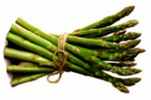ASPARAGUS
HOW TO ORDER
ASPARAGUS
Asparagus officinalis
Seed specs: Seeds per pound: 12,800
A member of the lily family, Liliaceae, asparagus is native to
southern Europe, southwestern England, and southern Ireland.
. It is a simple plant to produce and will give years of tender
spears in the spring.
Asparagus thrives in a deep sandy loamy soil. Two basic methods are
used to grow the plants - the bed and the row. The row
system is easier and faster to lay out, but the bed system should be
used on soil that is heavy or clay. Good preparation of
the planting area will ensure a strong crop.
An asparagus bed should be raised from the area around it
and should be prepared by digging the soil to a depth of about 24
inches. If the soil is clay, it is a good idea to mix in a
generous amount of sand, stone or broken brick to increase the
drainage. A good amount of compost or well rotted manure should be
worked into the bottom of the excavated area and bone meal worked
into the top layer.
In the row system, trenches are dug 6 inches deep, plants being set
at about 18 inches apart in the rows. Rows should be spaced at
3 feet apart.
Plants should be set out in early spring. To plant for either
the row or bed system, make a ridge 6 inches tall, then set the
plants with the crowns on the top of the ridge and the roots
trailing over the ridge. Then cover the roots up to the crown,
leaving just the top of the crown exposed. Water the plants
thoroughly after planting and keep them well watered during growing.
Harvesting should not be done until the third year, when the plants
will have become firmly established. Do not harvest after the
beginning of June (in the midwestern US) as the plants will need to
grow freely to establish strong plants for the following years
crop. At this time, it is beneficial to keep the plants
watered and fertilize them two or three times with a balanced water
soluable fertilizer. Keep the weeds controlled at all times in
the bed or rows. If you notice any weak plants, dig them
and discard.
Asparagus can also be grown from seed. Seed should be sown in
shallow drills in an area which has been worked thoroughly and the
soil is fine. To mark the rows, it is helpful to scatter a few
radish seeds. They emerge quickly and the rows can be seen for
hoeing. When the seedlings are about 3 inches high, they
should be thinned to a spacing of 3 inches apart in the rows.
The seedlings should be left to develop during the rest of the
season and not be moved until the following year when they should be
planted as above.
 Mary Washington
- An easily grown variety that produces very well. .
Mary Washington
- An easily grown variety that produces very well. .
| #634 Seed Packet $3.50 approximately 200
seeds |
ADD TO ORDER
|
| #B1z-634 Bulk seeds Approximately 800
seeds 1oz $10.50 |
ADD TO ORDER
|
| #B4z-634 Bulk seed 4oz approximately
12,800
seeds 1oz $20.50 |
ADD TO ORDER
|
| #P10-634H; 2-year roots,
quantity of 10 roots $15.00 |
ADD TO ORDER
|
| #P25-634H; 2-year roots,
quantity of 25 roots $24.95 |
ADD TO ORDER
|
| #P100-634H; 2-year roots,
quantity of 100 roots $66.00 |
ADD TO ORDER
|
| #B1z-634 Dried
powder 1oz $20.00 |
ADD TO ORDER
|
| #B1lb-634 Dried
powder 1lb $45.00 |
ADD TO ORDER
|
Asparagus UC 157 Developed at the University
of California in 1978, this variety is the most widely
planted asparagus type in the world. Perennial
producing early green spears with tight heads. Withstands
heat very well, is tolerant of rust and fusarium.
| #12208
Seed Packet
$7.50
Approximately 100
seeds |
ADD TO ORDER
|

There is great diversity in the vegetable varieties that we offer;
which makes the general information provided only valuable as
adjustable guidelines. This may also affect your seed planting and
propagation strategies and the germination rates under your
planting conditions may vary from the seed lot test results. The
following soil temperature data is for asparagus in general
(seed). Temperatures are average daytime from planting to
emergence. Percentage is average germination rate. Days is number
of days to emergence.
41ºF x 0% x 0 days; 50ºF x 61% x 53 days; 59ºF x 80%
x 24 days; 68ºF x 88% x 15 days; 77ºF x 95% x 10 days;
86ºF x 79% x 12 days; 95ºF x 37% x 19 days; 104ºF x
0% x 0 days;
ORDER EARLY!
See TERMS
Back to VARIETY INDEX
Terms HOME
 If you
have arrived in someone else's frame, or can not see all of the
other information available on richfarmgarden.com Click on logo to
enter from beginning
If you
have arrived in someone else's frame, or can not see all of the
other information available on richfarmgarden.com Click on logo to
enter from beginning
 Mary Washington
- An easily grown variety that produces very well. .
Mary Washington
- An easily grown variety that produces very well. .
 Mary Washington
- An easily grown variety that produces very well. .
Mary Washington
- An easily grown variety that produces very well. .

![]() If you
have arrived in someone else's frame, or can not see all of the
other information available on richfarmgarden.com Click on logo to
enter from beginning
If you
have arrived in someone else's frame, or can not see all of the
other information available on richfarmgarden.com Click on logo to
enter from beginning